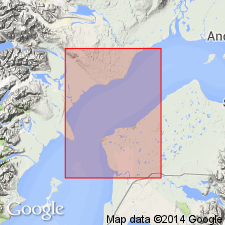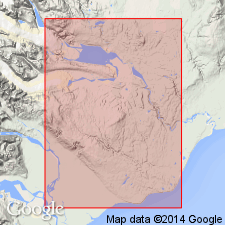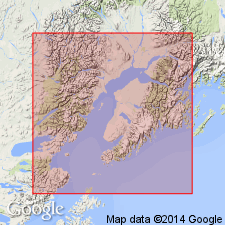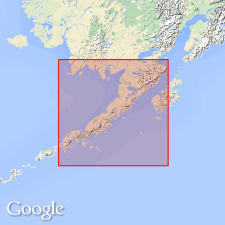
- Usage in publication:
-
- West Foreland Formation
- Modifications:
-
- Named
- Dominant lithology:
-
- Siltstone
- Claystone
- Coal
- AAPG geologic province:
-
- Alaska Southern region
Summary:
Named as lowermost formation (of 5) of Kenai Group. Type section designated in Pan American Pet. Corp. West Foreland No.1 well, 880 ft from south line and 671 ft from east line, sec.21 T8N R14W, Seward Meridian, at depths 10,620 to 11,510 ft, west side of Cook Inlet, southern AK. Consists of tuffaceous siltstone and claystone with scattered sandstone and conglomeratic beds from 300 to 1000 ft thick. Unconformably overlies Mesozoic strata in central part of Cook Inlet basin. Unconformably underlies Hemlock Conglomerate (new) of Kenai Group. Age given as Tertiary.
Source: GNU records (USGS DDS-6; Menlo GNULEX).

- Usage in publication:
-
- West Foreland Formation*
- Modifications:
-
- Adopted
- AAPG geologic province:
-
- Alaska Southern region
Summary:
West Foreland Formation is adopted for Tertiary rocks on northwest flank of Cook Inlet basin near Capps Glacier and along Chuitna River, southern AK. Unit consists of conglomerate 366 m thick. Unconformably overlies Mesozoic rocks. In basin to southeast underlies Hemlock Conglomerate also unconformably underlies Tyonek Formation. [Note: West Foreland is not adopted as formation in Kenai Group].
Source: GNU records (USGS DDS-6; Menlo GNULEX).

- Usage in publication:
-
- West Foreland Formation*
- Modifications:
-
- Age modified
- Biostratigraphic dating
- Areal extent
- AAPG geologic province:
-
- Alaska Southern region
- Alaska Southwestern region
Summary:
Correlation chart shows age of West Foreland Formation ranges from latest Paleocene in Chuitna River and Capps Glacier to early Eocene (Franklinian Stage) in Copper Lake, Cape Douglas, East Glacier Creek and Homer area based in part on plant fossils.
Source: GNU records (USGS DDS-6; Menlo GNULEX).

- Usage in publication:
-
- West Foreland Formation*
- Modifications:
-
- Areal extent
- AAPG geologic province:
-
- Alaska Southwestern region
Summary:
West Foreland Formation geographically restricted from Cape Douglas area. Strata is reassigned to Copper Lake Formation based on lithology.
Source: GNU records (USGS DDS-6; Menlo GNULEX).
For more information, please contact Nancy Stamm, Geologic Names Committee Secretary.
Asterisk (*) indicates published by U.S. Geological Survey authors.
"No current usage" (†) implies that a name has been abandoned or has fallen into disuse. Former usage and, if known, replacement name given in parentheses ( ).
Slash (/) indicates name conflicts with nomenclatural guidelines (CSN, 1933; ACSN, 1961, 1970; NACSN, 1983, 2005, 2021). May be explained within brackets ([ ]).

